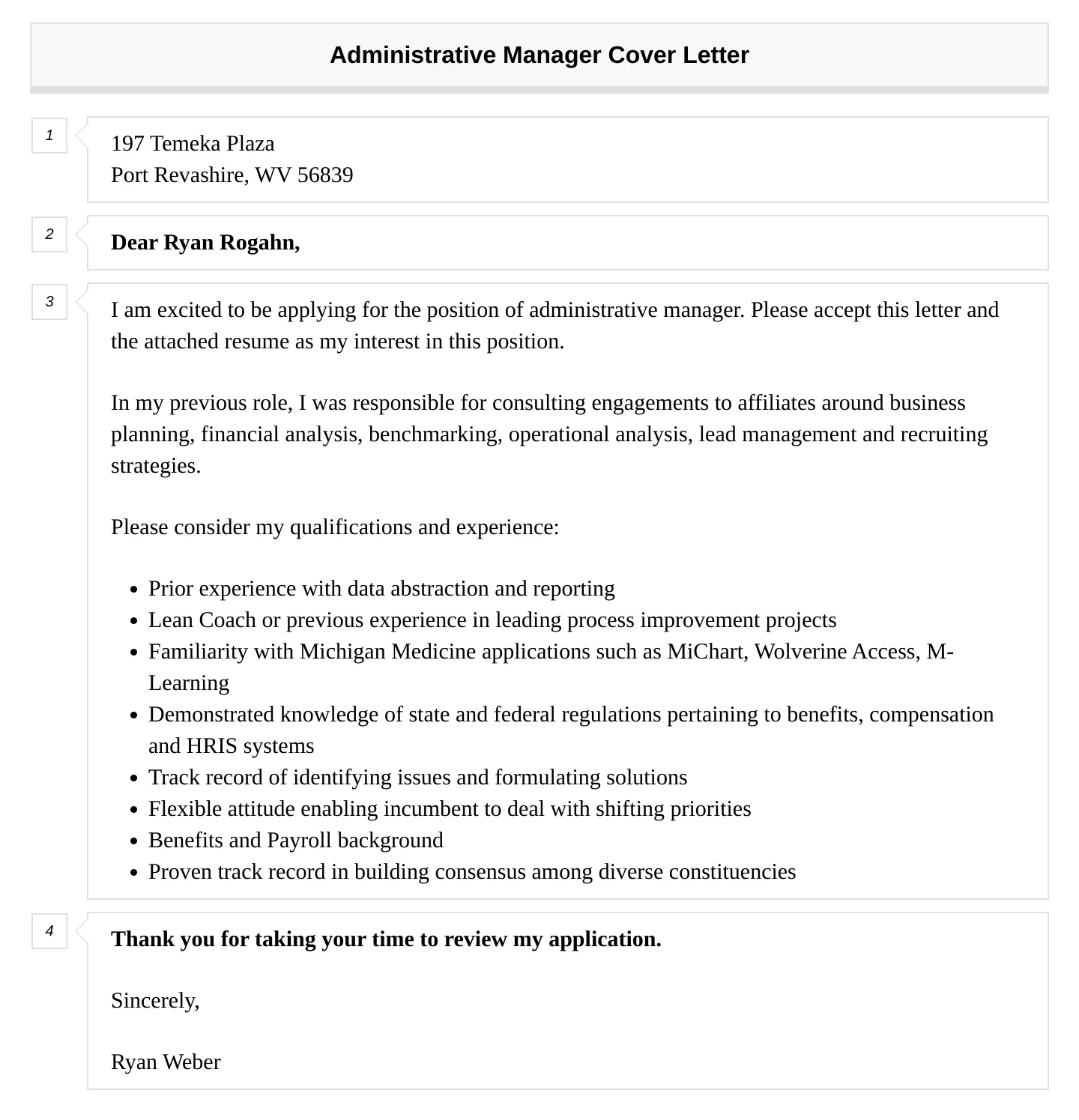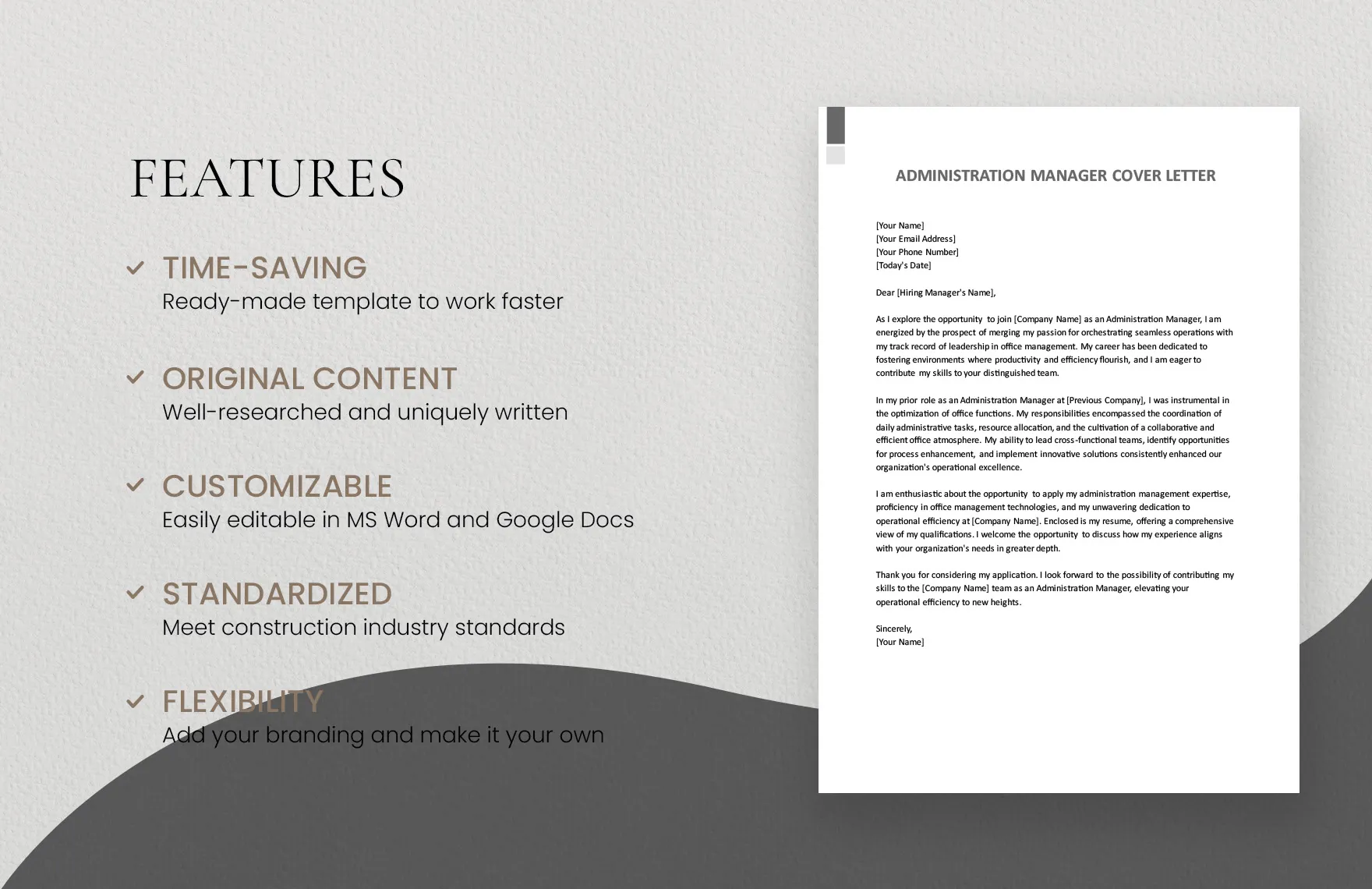Crafting a Compelling Cover Letter
A well-crafted cover letter is your first opportunity to make a lasting impression on a hiring manager. Think of it as your personal sales pitch, a chance to showcase not just your skills but also your personality and enthusiasm for the administrative manager position. The goal is to grab their attention from the start, demonstrating that you’re not just qualified, but the perfect fit for their team. Begin with a strong opening that immediately captures their interest. This could be a brief anecdote, a statement about your passion for administration, or a specific detail about the company that resonates with you. Remember, the initial lines are crucial; they set the tone and determine whether the reader will continue reading. Therefore, invest time in perfecting this opening. Your cover letter needs to be more than a regurgitation of your resume. It needs to provide context, expand on your experiences, and demonstrate a clear understanding of the role and the organization’s needs. Use this space to articulate your career goals and how they align with the administrative manager position and the company’s objectives. This proactive approach will make you appear as someone who is truly invested in the opportunity.
Highlighting Your Administrative Skills
Administrative managers require a diverse set of skills. Your cover letter is the perfect place to emphasize the ones most relevant to the job description. Start by listing your key administrative skills, such as organization, time management, communication (both written and verbal), and proficiency in relevant software (Microsoft Office, Google Workspace, etc.). Provide specific examples of how you’ve utilized these skills to achieve positive outcomes in past roles. For instance, describe a time you implemented a new filing system that improved efficiency, or how you managed a complex project while keeping all stakeholders informed and on track. Don’t just list your skills; provide evidence of your capabilities. Furthermore, many administrative roles involve team leadership or collaboration. If you have experience managing teams, coordinating projects, or facilitating communication among different departments, be sure to highlight these skills. Use the STAR method (Situation, Task, Action, Result) to provide concrete examples of your accomplishments. This method ensures your examples are clear, concise, and impactful, demonstrating the value you would bring to the administrative manager position. Show, don’t just tell, the hiring manager what you can do.
Detailing Relevant Experience

Your work experience is the backbone of your cover letter. The key is to present it in a way that highlights your suitability for the administrative manager role. Focus on positions where you held responsibilities similar to those outlined in the job description. For each role, briefly describe your key duties and responsibilities. More importantly, delve into specific achievements and how they benefited the company or organization. It’s not enough to state that you “managed office operations”; you need to demonstrate how you improved efficiency, reduced costs, or enhanced employee satisfaction. Tailor your experience to match the specific requirements of the administrative manager position. Review the job description carefully and identify the key skills and experiences the employer is seeking. Then, select the most relevant examples from your work history and emphasize those in your cover letter. If you’re transitioning into an administrative manager role from a different field, focus on transferable skills and accomplishments that demonstrate your adaptability and ability to learn quickly. Clearly articulate how your previous experiences have prepared you for this new opportunity. Consider using bullet points within your descriptions to make the content more readable and the information easier to absorb.
Quantifying Achievements
Numbers speak volumes. To truly make your achievements stand out, quantify them whenever possible. Instead of saying, “Improved office efficiency,” state, “Improved office efficiency by 15% within six months by implementing a new scheduling system.” Quantifiable data provides concrete evidence of your impact and makes your claims more credible. Think about the results you’ve achieved in past roles. Did you reduce costs, increase productivity, improve customer satisfaction, or streamline processes? If so, provide specific numbers or percentages to illustrate these improvements. For example, you might write, “Reduced office supply costs by 10% through strategic vendor negotiations.” When possible, use metrics that align with the goals and objectives of the administrative manager position. Show the hiring manager that you understand what matters most to the organization and that you have a proven track record of delivering results. Be sure the numbers you provide are accurate and verifiable. Avoid making exaggerated claims, as this could damage your credibility. The goal is to present a clear and compelling picture of your accomplishments, backed by solid data.
Formatting Your Cover Letter for Success
The format of your cover letter is just as important as its content. A well-formatted letter is easy to read, visually appealing, and demonstrates professionalism. Start by choosing a professional font, such as Times New Roman, Arial, or Calibri, and use a font size of 11 or 12 points. Ensure your letter is well-spaced and organized with clear paragraphs and headings. This makes it easier for the hiring manager to scan and grasp the key information quickly. Pay attention to the layout. Use standard business letter format, including your contact information, the date, the hiring manager’s name (if available), and the company’s address. Keep the letter concise, aiming for one page maximum. Use clear and concise language. Avoid jargon and overly complex sentences. The goal is to communicate your qualifications effectively and efficiently. Use bullet points to highlight key skills and accomplishments, making the information easier to digest. Proofread the cover letter carefully for any errors in grammar, spelling, or punctuation. Errors can undermine your credibility, so always take the time to review your letter before submitting it. Consider using a template as a starting point, but always customize it to fit the specific job and your unique qualifications.
Tailoring Your Letter to the Job

One of the most effective ways to increase your chances of landing an interview is to tailor your cover letter to the specific job and company. Generic cover letters are easily spotted and often discarded. Take the time to carefully review the job description, paying close attention to the required skills, experiences, and qualifications. Then, customize your cover letter to address these specific requirements. Show the hiring manager that you understand the role and the needs of the organization. Research the company and its values. Demonstrate your knowledge by mentioning specific projects, initiatives, or goals that resonate with you. Highlight how your skills and experiences align with the company’s mission. Avoid using generic phrases or clichés. Instead, use specific examples that showcase your understanding of the company’s needs. Demonstrate your genuine interest in the position and the organization. Show that you have taken the time to understand the role and that you are genuinely excited about the opportunity. By personalizing your cover letter, you’ll stand out from the crowd and increase your chances of getting noticed. This level of personalization shows initiative and a proactive approach to your job search.
Proofreading and Editing Your Cover Letter
Before you submit your cover letter, proofreading and editing are absolutely crucial. Your cover letter is a reflection of your attention to detail and your communication skills. Errors can create a negative impression and could disqualify you from consideration. Read through your letter carefully, checking for any errors in grammar, spelling, punctuation, and sentence structure. Consider reading your letter aloud to catch awkward phrasing or inconsistencies. Take a break and then come back to your cover letter with fresh eyes. It can be difficult to spot errors when you have been staring at the same text for a long time. Ask a friend or colleague to review your cover letter. A second pair of eyes can often catch errors that you might miss. Ensure that all the information in your cover letter is accurate and up-to-date. Verify that all the dates, names, and titles are correct. Make sure your contact information is accurate. Proofreading is not just about catching errors; it’s about ensuring your cover letter is clear, concise, and compelling. The goal is to present yourself in the best possible light. By taking the time to proofread and edit your cover letter, you increase your chances of making a positive impression and landing an interview for the administrative manager position.
In conclusion, a well-crafted cover letter is a critical component of your job application, particularly for administrative manager roles. By following these proven hacks – crafting a compelling introduction, highlighting your relevant skills, detailing your experience, quantifying your achievements, formatting your letter effectively, tailoring your content to each job, and proofreading diligently – you’ll significantly increase your chances of capturing the hiring manager’s attention and securing an interview. Remember to always showcase your value and enthusiasm for the position, and demonstrate how you can contribute to the organization’s success. Your cover letter is not merely a formality, but an opportunity to impress, so take the time to make it count. Good luck with your job search!
